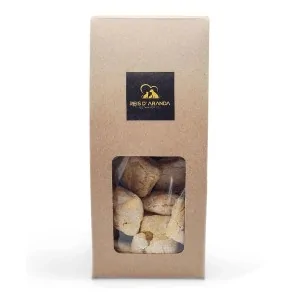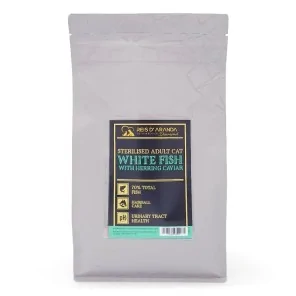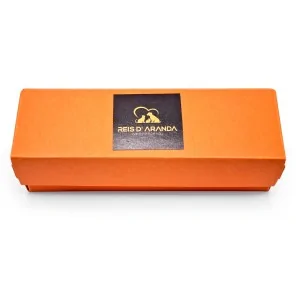Its name says it all: the Vienna blue rabbit comes from Austria. Not only is it beautiful with its shiny blue-grey...
DOMESTIC ABANDONMENT
WHAT IS "DOMESTIC NEGLECT"?
When people talk about abandonment at political rallies, in speeches by protectionist associations or in the media, we never hear the term "domestic abandonment"; and no, it is not a name we have invented, but its presence is as silent as it is "well seen" by more than one owner.
Domestic neglect" is, precisely, knowingly ignoring that our animal has an ailment, pathology or needs (physical or psychological) when these have a solution.
TYPES OF "DOMESTIC NEGLECT
- KNOTTED BLANKETS:
When we acquire a long-haired or double-coated animal (such as the German spitz, the teddy rabbit or the Persian cat), it is our obligation to take proper care of the maintenance of its coat, which we must brush every day to prevent it from tangling or accumulating wool from moulting, which over time ends up producing large layers of knots that end up joining together, making what we call "knotted blankets".
This type of "domestic neglect" is all too common in pet grooming salons, mainly because owners do not want to spend the money to take their pet every month; they come every three, six or even twelve months to have the professional "fix" the mess they have made, because in all that time they have not brushed their pet either.
Knot blankets are extremely dangerous, as they prevent oxygenation of the skin and, in the worst cases, blood circulation in sensitive areas such as the tail, wrists, ankles and ears.
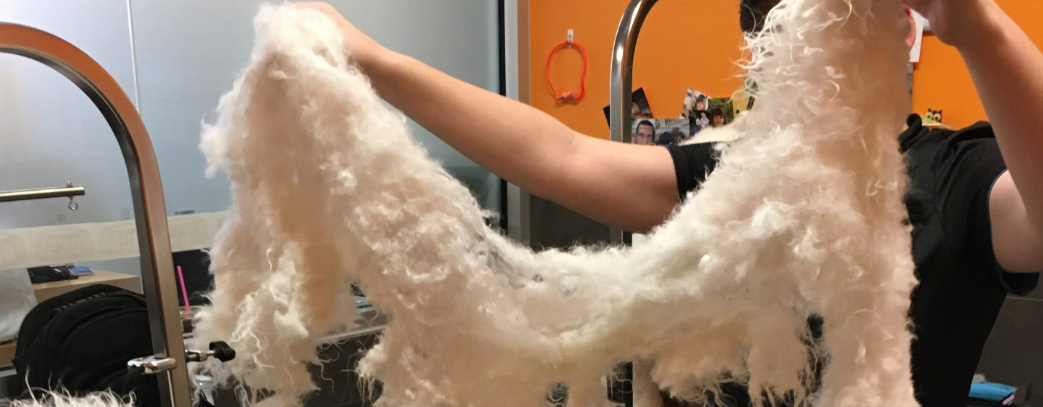
(Above: Knotted blanket on a dog)
CONSEQUENCES OF KNOTTED BLANKETS:
-Itchiness
-Irritations
-Dermatitis (dry or seborrhoeic)
-necrosis in sensitive areas (tail, ears, wrists and ankles)
-Fungus (if the owner washes him and he cannot dry well).
- EXCESSIVE TARTAR BUILD-UP:
Tartar build-up is very common in small and medium-sized dog breeds, and can occur equally (though less frequently) in large dogs, and is also not uncommon in cats (though equally infrequently).
Tartar accumulation is a multifactorial issue (it has different causes), including:
-Genetics of that particular animal
-Excessively soft food (overuse of cans or pâtés)
-Lack of toys or snacks to chew on
Lack of cleanliness in small breeds by the owners -Lack of cleanliness in small breeds by owners
-Age
-Teeth too small and too close together (crowding).

(ABOVE: A dog's mouth infected by tartar, at a very advanced stage.)
This pathology (because it is a disease) is quite common and more than one owner ignores it because he does not want to put the dog in the operating theatre for cleaning, does not want to have teeth removed or does not want to spend the money.
Excessive tartar build-up is not only unsightly and smells awful (in the worst cases, the whole house can smell terrible due to the dog's panting), but it is also very dangerous for the health of both the dog and his family.
This sounds like an exaggeration, doesn't it? It is not. The accumulation of tartar damages the gums and the roots of the teeth, causing pain, chewing problems and abscesses of greater or lesser severity, when the dog swallows it is swallowing its own bacteria and these pass into the bloodstream, so the chances of suffering heart or neurological problems due to these same bacteria shoots up; Because of the pain, many animals stop eating and, in addition, every time it sucks us and we touch our eye without realising it or eat something without washing our hands, we are swallowing those same bacteria.
The only excuse for not solving this problem is if the animal is extremely old, suffers from liver or kidney problems or is hypersensitive to anaesthesia/sedation.
- DISEASES DUE TO POOR HYGIENE:
We are all aware that living amongst filth brings disease, so why do some people allow their animals to live in filthy areas?
In this case, living in a filthy environment, full of dirty substrate, urine and faeces is more common in small pets than in large ones. It doesn't matter if the breeder has told you step by step how to keep your pet correctly, if he has given you a dossier that the owner has signed himself (showing that he has read it and, therefore, knows the minimum he has to do), it doesn't matter if the groomer of your rabbit or guinea pig explains it to you or if the vet gives you a warning; there are people who do not learn and who love to have their pet at home but cleaning is tedious, boring or disgusting for them.
I ask myself, what do you keep your pet for then?
It doesn't matter if your rabbit or guinea pig lives in a park or large cage, if you don't clean it will end up developing diseases specific to dirt:
- DAMP PODODERMATITIS:
Pododermatitis is one of the most common diseases in rabbits and guinea pigs, it is multifactorial (it has several causes) but, in this case, we are going to focus on pododermatitis caused by dampness.
When your rabbit or guinea pig lives in a very, very dirty cage or park, the ground it walks on (blankets, substrates...) is constantly wet from urine, the urine is very acidic and when an area of the body is in constant contact with urine, it is not cleaned or dried, the animal's fur ends up burning, it falls out, the skin becomes irritated...
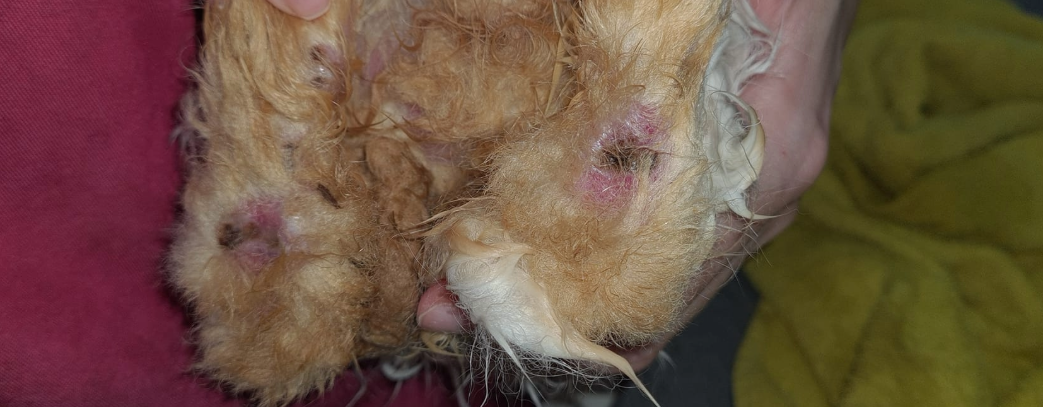
(ABOVE: Moisture pododermatitis in an adult rabbit)
In pododermatitis, this disease is centred on the palms of the hands and feet, producing very painful ulcers which must be treated as soon as possible; otherwise, if left untreated, these ulcers can reach the bones and can lead to necrosis and bone infections.
Mild pododermatitis (a slight bald spot on the heels or toes) can be treated at home with some advice, but in moderate and severe cases (like the picture we can see, where the animal is soaked with urine) it is urgent to go to the vet, apply all the appropriate treatments, put "shoes" on the animal to protect the area and, in the worst cases, go to the operating theatre.
UNTREATED MALOCCLUSION:
We have already talked before about malocclusion, how serious it is and that, due to the rapid growth of teeth in small animals, it can get out of hand at any time but, when we know that our pet suffers from this malformation (from birth or acquired by any cause) it is important to keep a strict follow-up of it at the vet or, opt for the most comfortable and quickest solution: remove the teeth.
The problem comes when the owner does not want to solve the problem or does not want to spend the money, even when the follow-up is not strict: the teeth grow and become deformed to an unthinkable extent.
In this photo, we see some incisors of an adult rabbit with genetic malocclusion, at first glance it does not seem so serious, but the upper incisors are turned backwards forming a ring that sticks into the palate.
When the malocclusion is not treated, the teeth become deformed causing pain, fractures in the jaw, ulcers, perforations (lip, cheek, palate or tongue), starvation (the animal does not eat because of the pain) and death.
- OBESITY AND OVERWEIGHT:
Although some people are determined to convince people that obesity and being overweight is a good thing and something to be proud of, we have to be realistic: NO. Obesity and being overweight are not good for our animals and even less so.
It is very common for pets (especially dogs and cats) to suffer from obesity and overweight, sometimes to the most aberrant extreme, and although their owners know about it, are amused or don't care, they do nothing to remedy it.
Our pets cannot tell when they are too fat or when they have eaten too much, but they eat whatever we offer them.
Being overweight or obese carries the following dangers:
-Heart problems
-Respiratory problems
-Cerebrovascular problems
-Diabetes
-Joint problems
-Pain
Infections in the skin folds -Skin folds infections
-Ulcers (due to rubbing of the folds of skin)
-Death
-Complications in the operating theatre or with anaesthesia
-Cancer
If our pet is obese and we allow it to become obese by doing nothing to correct it, we are being grossly negligent.
We are killing our pet little by little.
CONCLUSION
As we can see, to abandon or mistreat an animal we don't have to throw it out on the street, not feed it or beat it, but some of the actions we experience on a daily basis are examples of this.
In this article, we have not focused on "silly" concepts of what mistreatment is, but as professionals we have spoken based on our daily experiences.
Leave a comment
Log in to post comments
Comments
Saludos desde DF
By: Julieta R. Castillo On 05/19/2024Mi perrhijo tiene muy mal olor de boca y sus dientecitos se ven como esa foto :( no sabía que estaba tan mal porque él come y se ve feliz, gracias x la información
Más habitual de lo que la gente cree
By: Rosa On 05/19/2024Soy auxiliar de veterinaria y siempre escuchamos lo de "se lo acabo de ver" cuando hay gusanos en la herida y apesta a podrido...
El pan de cada día
By: Macarena S. On 05/19/2024Trabajo en una peluquería canina y ver cosas de estas es el pan de cada día, no hay perro que venga en perfectas condiciones y encima cuando le avisas al dueño para que mejore y su mascota tenga un mayor nivel de bienestar se ofenden.
Pobres angelitos
By: Susi On 05/05/2024No sé como se puede tratar así a estos angelitos inocentes :( Y encima viven dentro de su casa y tienen una familia que los quiere! (o eso deberían)
Es muy triste, yo me dejo mucho dinero en mi cuyhija, es mi luz y no quiero que llegue el día en el que se muera.


